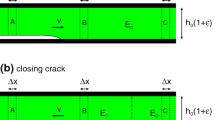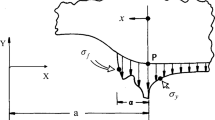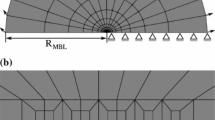Abstract
A theory is developed for predicting the time-dependent size and shape of cracks in linearly viscoelastic, isotropic media. First, the effect of a narrow zone of disintegrating material at the crack tip on opening displacement and on a finite stress distribution ahead of the tip is examined for elastic materials. Extension to viscoelastic media is then made. Although the undamaged portion of the continuum is assumed linear, no significant restrictions are placed on the nature of the zone of failing material at the crack tip and, therefore, this material may be highly nonlinear, rate-dependent, and even discontinuous. Finally, formulation of the problem is completed by introducing a local energy criterion of failure at the tip which is applicable to both constant and transient tip velocities. Parts II–IV, to appear in succeeding issues, will cover approximate methods of analysis and several applications of the theory.
Résumé
On développe une théorie pour prédire l'évolution en fonction du temps de la dimension et de la forme de fissures dans des milieux isotropes à viscoélasticité linéaire. On examine d'abord, dans le cas de matériaux élastiques, l'effet d'une zône étroite de matériau désintégré à la pointe de la fissure sur le déplacement d'ouverture de cette fissure, et sur la distribution des contraintes finies devant cette extrémité. En dépit d'une hypothèse de linéarité de la portion non affectée du continuum, il n'apparaît pas de restrictions significatives sur la nature de la zône où, à la pointe de la fissure, se dégrade le matériau. Dès lors, celui-ci peut avoir une forte non-linéarité, posséder des propriétés mécaniques dépendantes de la vitesse, et même être discontinu. On achève enfin la formulation du problème en introduisant un critère local d'énergie de rupture à l'extrémité de l'entaille. Ce critère est applicable aussi bien aux vitesses constantes qu'aux vitesses transitoires de fissuration. Des méthodes d'analyse approchées, ainsi que diverses applications de la théorie seront données dans les parties II–IV à paraître prochainement.
Zusammenfassung
Eine Theorie zur Voraussagung der zeitabhängigen Ausdehnung und Form, von Rissen in linearen viskoelastischen isotropen Medien, wird aufgestellt. Zuerst wird der Einfluß einer schmalen Zone von zersetztem Material an der Rißspitze auf die Rißöffnungsausdehnung und auf eine endliche Spannungsverteilung vor der Rißspitze für elastisches Material untersucht. Nachher wird der Übergang auf viskoelastische Medien gemacht. Obschon der unbeschädigte Anteil des Kontinuums als linear angenommen wird, werden keine merkenswerte Einschränkungen über die Natur der Zone von nachgebendem Material an der Rißspitze gemacht. Dadurch kann dieses Material stark unlinear, Geschwindigkeitsabhängig, und sogar diskontinuierlich sein. Am Ende wird die Gestaltung des Problems durch Einführung eines örtlichen Energiekriteriums für den Bruch an der Rißspitze, das sowohl auf beständige als auf Übergangs-Rißspitzengeschwindigkeiten anwendbar ist, vervollständigt. Teile II bis IV enthalten Annäherungsuntersuchungsverfahren und mehrere Anwendungen der Theorie. Diese werden in folgenden Ausgaben erscheinen.
Similar content being viewed by others
References
R. A. Schapery, Viscoelastic Behavior and Analysis of Composite Materials, Texas A & M Univ., Rpt. MM 72–73, August 1972 (to appear in Composite Materials, 2, G. P. Sendeckyj, Ed., Academic Press, 1974).
W. G. Knauss, The Mechanics of Polymer Fracture, Applied Mechanics Reviews, 26 (1973) 1–17.
M. L. Williams, Initiation and Growth of Viscoelastic Fracture, Int. J. Fracture Mechanics, 1 (1965) 292–310.
M. P. Wnuk and W. G. Knauss, Delayed Fracture in Viscoelastic-Plastic Solids, Int. J. Solids Structures, 6 (1970) 995–1009.
W. G. Knauss, Delayed Failure—The Griffith Problem for Linearly Viscoelastic Materials, Int. J. Fracture Mechanics, 6 (1970) 7–20.
H. K. Mueller and W. G. Knauss, Crack Propagation in a Linearly Viscoelastic Strip, J. Applied Mechanics, 38, Series E (1971) 483–488.
W. G. Knauss and H. Dietmann, Crack Propagation Under Variable Load Histories in Linearly Viscoelastic Solids, Int. J. Engineering Sciences, 8 (1970) 643–656.
B. V. Kostrov and L. V. Nikitin, Some General Problems of Mechanics of Brittle Fracture, Archiwum Mechaniki Stosowanej, 22, English Version (1970) 749–776.
W. G. Knauss, On the Steady Propagation of a Crack in a Viscoelastic Sheet: Experiments and Analysis, Presented at the Battelle Colloq. on Deformation and Fracture of High Polymers, Kronberg, Germany (Sept. 1972) (To appear in: Deformation and Fracture of High Polymers, H. H. Kausch and R. Jaffee, Eds., Plenum Press, 1973).
R. P. Kambour, Mechanism of Fracture in Glassy Polymers, III. Direct Observation of the Craze Ahead of the Propagating Crack in Poly(methyl methacrylate) and Polystyrene, J. Polymer Science, Part A.2, 4 (1966) 349.
G. I. Barenblatt, The Mathematical Theory of Equilibrium Cracks in Brittle Fracture, in: Advances in Applied Mechanics, Vol. VII, Academic Press (1962) 55–129.
D. S. Dugdale, Yielding of Steel Sheets Containing Slits, J. Mech. Phys. Solids, 8 (1960) 100–104.
G. T. Hahn and A. R. Rosenfield, Local Yielding and Extension of a Crack Under Plane Stress, Acta Metallurgica, 13 (1965) 293–306.
A. S. Tetelman and A. J. McEvily, Jr., Fracture of High-Strength Materials, in: Fracture, VI, H. Liebowitz Ed., Academic Press (1969) 137–180.
M. L. Williams, On the Stress Distribution at the Base of a Stationary Crack, J. Applied Mechanics, 24 (1957) 109–114.
Y. C. Fung, Foundations of Solid Mechanics, Prentice-Hall (1965).
G. A. C. Graham, The Correspondence Principle of Linear Viscoelasticity Theory for Mixed Boundary Value Problems Involving Time-Dependent Boundary Regions, Q. Applied Math., 26 (1968) 167–174.
S. Timoshenko and J. N. Goodier, Theory of Elasticity, McGraw-Hill, 2nd Ed. (1951).
J. D. Ferry, Viscoelastic Properties of Polymers, 2nd Ed., Wiley (1970).
R. A. Schapery, On a Theory of Crack Growth in Viscoelastic Media, Texas A & M Univ., Rpt. MM 2764-73-1, March (1973).
J. N. Goodier, Mathematical Theory of Equilibrium Cracks, in: Fracture, II, H. Liebowitz Ed., Academic Press (1968) 1–66.
B. Van der Pol and H. Bremmer, Operational Calculus, Cambridge (1955).
G. A. C. Graham, Two Extending Crack Problems in Linear Viscoelasticity Theory, Q. Applied Mathematics, 27 (1969) 497–507.
Author information
Authors and Affiliations
Rights and permissions
About this article
Cite this article
Schapery, R.A. A theory of crack initiation and growth in viscoelastic media. Int J Fract 11, 141–159 (1975). https://doi.org/10.1007/BF00034721
Received:
Revised:
Issue Date:
DOI: https://doi.org/10.1007/BF00034721




